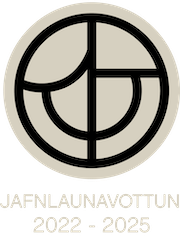Rafeinda- og kjarnafærslur í sólhlöðum með járnefldri næmni: Samhæft líkan fyrir ferlið frá gleypni ljóss til aðskilnaðar hleðslanna - verkefni lokið
Fréttatilkynning verkefnisstjóra
Örvað ástand er grundvöllur fyrir umbreytingu ljóss í orku og fyrir virkni sólarrafhlaða þar sem næmni er aukin með litarefnum úr algengum málmum. Í þessu verkefni var nýstárleg aðferð þróuð til að framkvæma tölvuútreikninga á örvuðu ástandi.
Aðferðin byggir á leit eftir ferlum orkulandslagsins með tilliti til frelsisgráða rafeinda og örvað ástand er fundið með samleitni á söðulpunktum landslagsins. Víðtækur samanburður sýnir að þessi nálgun er traustari en sambærilegar aðferðir. Tölvuútreikningar á örvuðu ástandi með þéttfellnifræði hafa nytsamlega eiginleika fyrir rannsóknir á ferlum við upptöku ljóss í sólarrafhlöðum: þeir eru hagkvæmir og lýsa bæði færslu á hleðslum og kröftum atóma með nákvæmni, og þar með nýtast í útreikninga á varmafræðilegum færslum atómanna. Það sem meira er, þessi aðferð getur lýst margþættum stöðuorkuföllum þar sem örvun rafeinda er líklegust til að eiga sér stað, og getur þar af leiðandi lýst varmafræðilegum færslum á rafeindum. Verkið hefur verið unnið á Raunvísindastofnun í samvinnu við próf. Hannes Jónsson. Þéttnifellireikningar byggðir á hnikareglu hafa verið notaðir í margskala reikningum á klassískum ferlum til að lýsa færslu atóma eftir að kopar komplex í asítónítril leysi hefur tekið upp ljóseind. Með þessum reikningum var hægt að túlka mælingar með tímagreindu röntgen endurvarpi sem samverkamenn gerðu við stóra rannsóknastöð fyrir röntgenmælingar. Saman sýna mælingarnar og reikningarnir hvernig gangur ferlisins er á smásæum skala og hvernig skautaður leysir ásamt ljósnæmi komplexins ákvarða hreyfingu atómanna á mjög stuttum tímaskala. Þar með var hægt að leysa úr ágreiningsatriðum sem höfðu komið upp varðandi túlkun mælinganna. Þessar rannsóknir hjálpa til við að þróa viðmið sem hjálpa til við að bæta virkni ljósörvara fyrir sólhlöður sem einungis innihalda algeng frumefni á jörðinni.
English:
Excited electronic states play a fundamental role in devices for solar energy conversion, including dye-sensitized solar cells. In this project, a novel method for calculating excited states has been developed. It is based on direct optimization of the energy, whereby excited states are obtained by converging on saddle points on the surface that specifies how the energy varies as a function of the electronic degrees of freedom. Extensive tests carried out on excited states of molecules using density functional approximations show that the new method is more robust than previous approaches. Such variational density functional calculations of excited states have several appealing features for use in studies of photoinduced processes in solar cells: They are computationally efficient, can describe charge transfer excitations well, and provide atomic forces for simulations of the dynamics of the atoms. Moreover, in this project it has been found that the method can describe multiple potential energy surfaces where electronic transitions are most likely to occur, which is important for modelling electron dynamics. The development has been carried out at the Science Institute of the University of Iceland in collaboration with Prof. Hannes Jónsson. Variational density functional calculations of excited states have then been used in multiscale molecular dynamics simulations of the photoinduced atomic structural dynamics of a copper complex photosensitizer in acetonitrile. These simulations were key to the interpretation of time-resolved X-ray scattering experiments performed at a large-scale X-ray facility by collaborators abroad. Together, the experiments and the simulations unravelled the microscopic mechanisms that govern the influence of a polar solvent on the ultrafast structural dynamics and the relationship with the photosensitizing properties of the complex, resolving previous experimental controversies. Ultimately, these studies contribute to generating the guiding principles for improving the efficiency of photosensitizers for solar cells based on earth-abundant metals.
∙ Information on how the results will be applied.
The method developed in this project can extend the range of applicability of variational calculations of excited electronic states. It is currently being used and will be used in the group where the project has been carried out for further studies on systems for, e.g., photocatalysis, light harvesting, photoswitching. The method has been implemented in the open-source program GPAW. Therefore, it is freely available and, more in general, can be used by the photochemistry and material science communities for studies of photoactivated processes, where excited states play a role, such as vision, photosynthesis, and solar energy conversion. The new insights gained from the multiscale simulations on the photophysics of a copper complex photosensitizer can help identify ways to improve the efficiency of photosensitizers based on earth-abundant metals, such as copper, to replace rare and toxic metals, such as ruthenium, in dye-sensitized solar cells.
∙ A list of the project’s outputs
The method development performed in this project has resulted in the publication of four main scientific articles. Two have been published in the ACS Journal of Chemical Theory and Computation, a leading journal in theoretical and computational chemistry, one in The Journal of Physical Chemistry Letters, an ACS journal with high impact factor in physical chemistry, and one in the Faraday Discussions journal presented at a homonymous conference organized by the Royal Society of Chemistry (RSC). These articles include two first-author publications (cited 50 times as of beginning of 2023, according to Web of Science), and one last-author publication for the PI. The newly developed excited state method has been implemented and is available in an official release of the open-source program GPAW. The multiscale simulations have led to the publication of a first-author article for the PI on the RSC journal Physical Chemistry Chemical Physics (cited 19 times as of beginning of 2023, according to Web of Science), and to a last-author article on Chemical Science, a flagship journal of the RSC with a high impact factor, which includes the results of ultrafast X-ray scattering experiments performed by international collaborators.
Heiti verkefnis: Rafeinda- og
kjarnafærslur í sólhlöðum með járnefldri næmni: Samhæft líkan fyrir ferlið frá
gleypni ljóss til aðskilnaðar hleðslanna / Electron-Nuclear
Dynamics in Iron-Sensitized Solar Cells: A Unified Model Description from Light Absorption to Charge Separation
Verkefnisstjóri: Gianluca Levi, Háskóla Íslands
Tegund styrks: Nýdoktorsstyrkur
Styrktímabil: 2019-2021
Fjárhæð styrks kr. 29.970.000
Tilvísunarnúmer Rannís: 196070


